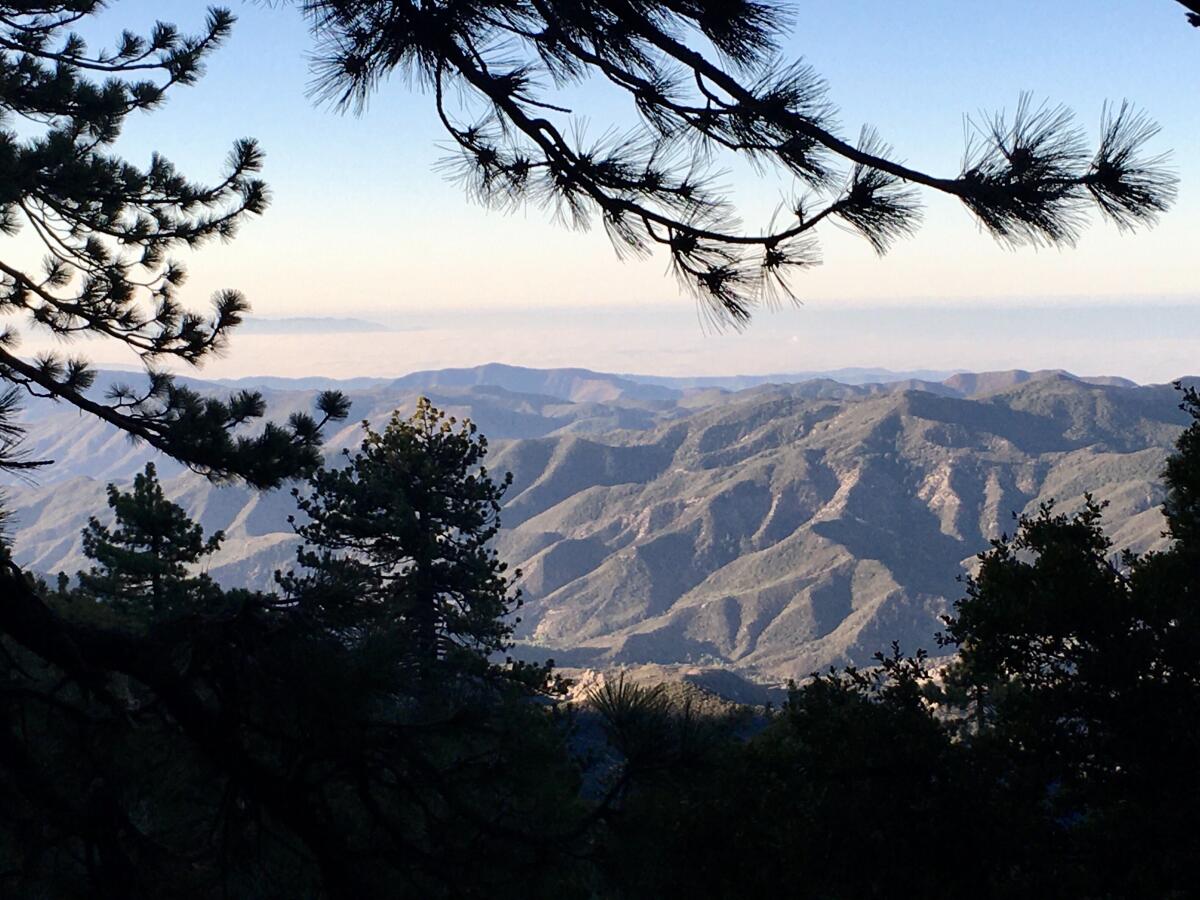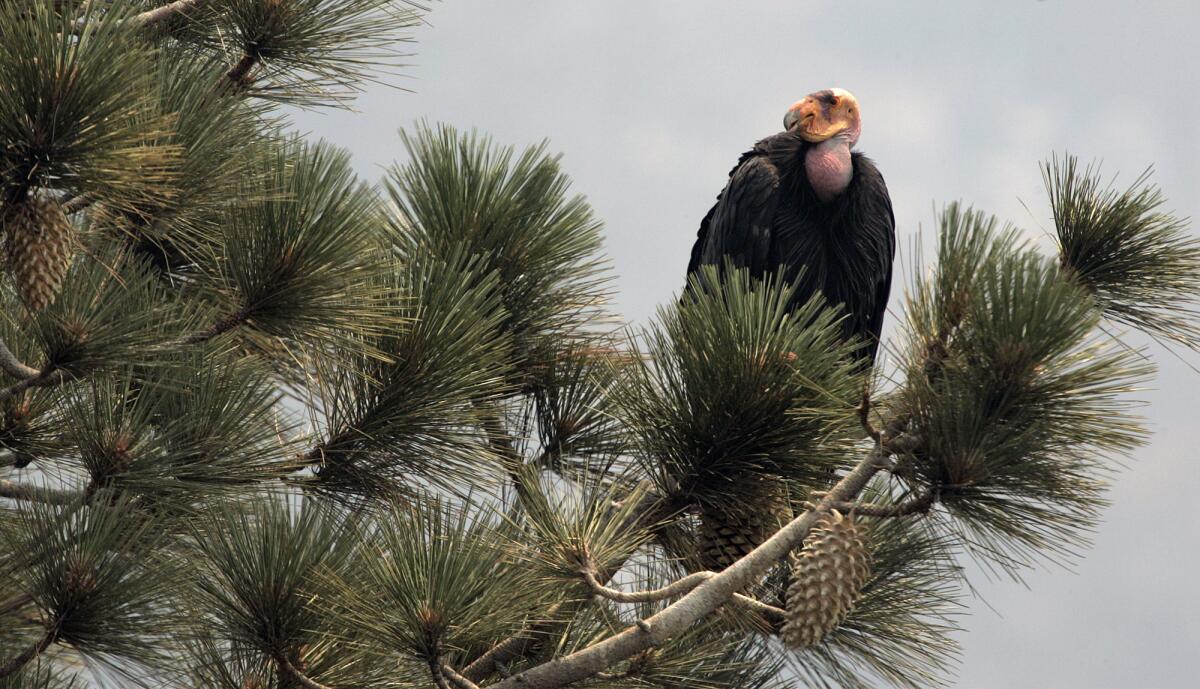A federal biologist learned he was fired while whale watching. Here’s his story (and warning)

- Share via
Good morning. Here’s what you need to know to start your day.
- He loved his job in Los Padres National Forest. Then Trump and Musk fired him.
- Noses can be made smaller, breasts bigger — and legs longer. Here’s the brutal procedure.
- This L.A. welder hosts coffin parties — but she does so much more to celebrate living.
- And here’s today’s e-newspaper.
You're reading the Essential California newsletter
The most important California stories and recommendations in your inbox every morning.
You may occasionally receive promotional content from the Los Angeles Times.
A fired federal biologist shares his story (and a warning)
Ben Vizzachero’s phone rang Saturday while he and his girlfriend were on a whale watching tour in Monterey Bay, celebrating the Valentine’s Day weekend. It was his supervisor with news he’d been bracing for.
“I’m fired,” Vizzachero more stated than asked. His supervisor confirmed what he already knew.
Their boat was still about an hour from port. Vizzachero spent that time watching the Pacific roll and the sea birds glide overhead as his new reality sank in.
“As soon as I got the news, I felt like I was going to vomit,” he said.
Vizzachero, 29, had worked as a federal biologist in Los Padres National Forest for just over a year. He is among the roughly 3,400 U.S. Forest Service workers who were laid off as part of President Trump and billionaire advisor Elon Musk’s push to reduce the federal government.

Vizzachero was emailed his termination letter shortly after the call.
“The Agency finds, based on your performance, that you have not demonstrated that your further employment at the Agency would be in the public interest,” Deedra Fogle, director of USFS Human Resource Management, wrote in the letter.
Vizzachero told me he feels angry, betrayed and reduced to “a pawn in this political game.” He followed a childhood dream to be an ornithologist and hit the biodiversity jackpot when he landed a position in Los Padres, which spans more than 1.7 million acres over four counties from the Monterey coast southeast to the Grapevine.
As he grieves a job he loved and figures out what’s next, he has a warning for the public: National forests and the communities around them will be less safe from fires, landslides and other hazards. And with thousands of his colleagues also out of work, Vizzachero said forest visitors and wildlife will suffer.
“These are the people that make sure the roads are drivable, make sure that the trails are hikable, make sure that the campgrounds are operating properly, report maintenance issues, make sure that our wildlife is safe — especially the threatened and endangered species,” he said.
“The forest is going to get caught with its pants down.”

Having fewer workers doing land management will hinder public safety and wildlife protections, Vizzachero said.
In his role as a compliance officer, he ensured that all USFS actions in Los Padres followed the law and took the necessary steps to reduce harm to the forest ecosystem.
That included the agency’s work to fight fires — both active blazes and proactive work that helps reduce the risk of severe wildfire and protect land and “homes within the wildland urban interface,” according to USFS officials.
One of Vizzachero’s priorities was to make sure firefighters were not disturbing California spotted owls and other vulnerable species during strategic firefighting and fuel thinning projects.
“Everything that I do as a biologist, as a compliance officer, was supporting those projects,” Vizzachero explained. “Now that I’m out of the picture … it’s going to be that much harder for these projects to continue and it is going to directly impact the safety of our communities from wildfire.”
Vizzachero had also recently gone through training to be a resource advisor for teams that monitor land during and after a wildfire to identify additional hazards, such as landslides.
“The government had already spent the money to train me up, to bring me on those teams so that I can help keep America safe, keep our resources safe, our wildlife and plants,” he said. “And now all of a sudden, I can’t do that.”
A U.S. Forest Service employee confirmed Vizzachero’s termination. They declined to provide further comment and asked not to be named for fear of putting their own job in jeopardy.

What’s next?
Vizzachero told me he’s fortunate to be part of a federal workers union that’s now preparing legal action.
“My understanding of what makes this firing illegal is that, being on my probationary period, I could only be fired if my performance is unsatisfactory, and I can clearly demonstrate that my performance is satisfactory,” he said.
Vizzachero sent me his first-year evaluation, in which he was deemed “fully successful” in meeting his performance goals.
“When the Wildlife Program lead position became vacant, Ben worked even harder to take on additional responsibilities,” his evaluator wrote. “Over the year he has invested time to learn the policies, apply that knowledge to requests, and provide guidance to leadership. He is receptive to feedback, driven to meet deadlines, and learns quickly. His hard work has been greatly appreciated!”
Vizzachero told me he plans to file for unemployment this week and start looking for another job, which he expects will be much more competitive with so many fellow biologists also on the hunt.
As he deals with all that, he also worries what’s next for the nation’s public lands, which he said are truly what makes America great.
“Those are the places that are open to exploring and … bring people together, create memories, create a sense of connection,” he said. “The fact that Donald Trump wants to gut our public land system, the fact that corporations and billionaires are gaining increasing control and power over what happens on our public lands is hurting America in a way that all of us will feel.”
Today’s top stories

Texts reveal strain between Mayor Karen Bass and L.A. County Supervisor Lindsey Horvath
- In correspondence obtained by The Times, L.A. County Supervisor Lindsey Horvath expressed frustration about L.A. Mayor Karen Bass’ lack of communication on fire recovery issues.
- The strain comes as the two politicians navigate what could be the costliest natural disaster in U.S. history.
A dozen wolves have been collared in California as officials seek to track the growing population
- State wildlife officials say the effort will help them monitor the expanding wolf population as well as provide information to ranchers who might lose cattle to wolves.
- There are now more satellite-collared wolves in the Golden State than ever before — 16 — which will mean enhanced monitoring of the growing wolf population.
A comprehensive look at DOGE’s firings and layoffs so far
- Thousands of federal government employees have been shown the door in the first month of President Trump’s administration.
- It is affecting more than just the Washington, D.C., area, home to about 20% of the 2.4 million members of the civilian federal workforce, which does not include military personnel and postal employees.
- More than 80% of that workforce lives outside the Washington area.
What else is going on
- A 97-year-old woman was left alone in a senior facility with the Eaton fire outside her window. What went wrong?
- After the Eaton fire, a bear makes a home its own, swimming in the pool, dining from the trash can, and ‘definitely not moving.’
- L.A. fast-food workers call on city officials to approve ‘fair work week’ law.
- Meta says it plans to build the world’s longest undersea internet cable.
- How Mexico’s president has kept Trump at bay — for now.
- More eggs are being confiscated at the U.S.-Mexico border amid the bird flu outbreak.
- Newsom proposes a $125-million mortgage relief package to help fire and other disaster victims.
- Can’t make rent because of the fires? L.A. County considers a six-month lifeline.
- The Dodgers have a record-setting payroll. Could their spending affect future CBA talks?
- Columbine survivor Anne Marie Hochhalter, who forgave shooter’s mother, dies at 43.
- A Cal Fire captain who battled the Eaton fire was killed by someone she likely knew, officials say.
- Nicolas Cage’s ex is suing him and their son. She says Weston Cage beat her and dad shares blame.
Get unlimited access to the Los Angeles Times. Subscribe here.
Commentary and opinions
- For California’s attorney general, the fight against Trump is personal, writes columnist Mark Z. Barabak.
- Republican Latinos are rising in California. Now there’s a caucus for them, columnist Gustavo Arellano writes.
- If conservatives want to help protect our system of government in this fragile moment, they should be welcomed to the fight, writes columnist Anita Chabria.
- Palm trees are about as L.A. as it gets, writes columnist Patt Morrison. But is it time to bid them a frond farewell?
This morning’s must reads

Noses can be made smaller, breasts bigger — and legs longer. Here’s the brutal procedure. What might seem crazy to some — cosmetic leg lengthening — is a growing business for Dr. Kevin Debiparshad, Dr. D to patients and staff, who does more than 100 of these surgeries a year. His patients have included tech bros, finance guys, social media influencers, athletes, actors and a well-known musician.
Other must reads
- Frustrated with crowded resorts, more skiers risk avalanche hazards in backcountry.
- Could this Irvine neighborhood be a blueprint for a more fire-resistant L.A.?
- ‘We are history.’ Long Beach native Hood Historian serves as the memory bank for L.A.
- NBCUniversal completes a green upgrade of its historic studio, bringing it more in line with its glamorous image as a storied movie factory and theme park known to the world.
How can we make this newsletter more useful? Send comments to [email protected].
For your downtime

Going out
- ⚰️This L.A. welder hosts coffin parties — but she does so much more to celebrate living.
- 🎶In a boom era for big music venues, the Shrine gets a facelift for its 100th anniversary.
Staying in
- 📙‘Stuck’ in place: Author Yoni Appelbaum traces America’s mobility crisis to a Modesto law enacted in 1885.
- 🥧 Here’s a recipe for Quarter Sheets’ grapefruit pie.
- ✏️ Get our free daily crossword puzzle, Sudoku, word search and arcade games.
A question for you: What’s your comfort TV show?
Kate Gieschen writes: “TED LASSO!!! Makes me believe in humanity again. Feels like a warm hug.”
Email us at [email protected], and your response might appear in the newsletter this week.
And finally ... from our archives

For the record:
10:11 a.m. Feb. 20, 2025A previous version of this newsletter stated John Glenn orbited the earth Feb. 20 1967. It was 1962.
On Feb. 20, 1962, John Glenn became the first American astronaut to orbit the Earth. In his first historic flight, Glenn circled the Earth for nearly five hours in his Friendship 7 spacecraft.
Have a great day, from the Essential California team
Ryan Fonseca, reporter
Defne Karabatur, fellow
Andrew Campa, Sunday reporter
Kevinisha Walker, multiplatform editor
Hunter Clauss, multiplatform editor
Christian Orozco, assistant editor
Stephanie Chavez, deputy metro editor
Karim Doumar, head of newsletters
Check our top stories, topics and the latest articles on latimes.com.
Sign up for Essential California
The most important California stories and recommendations in your inbox every morning.
You may occasionally receive promotional content from the Los Angeles Times.




